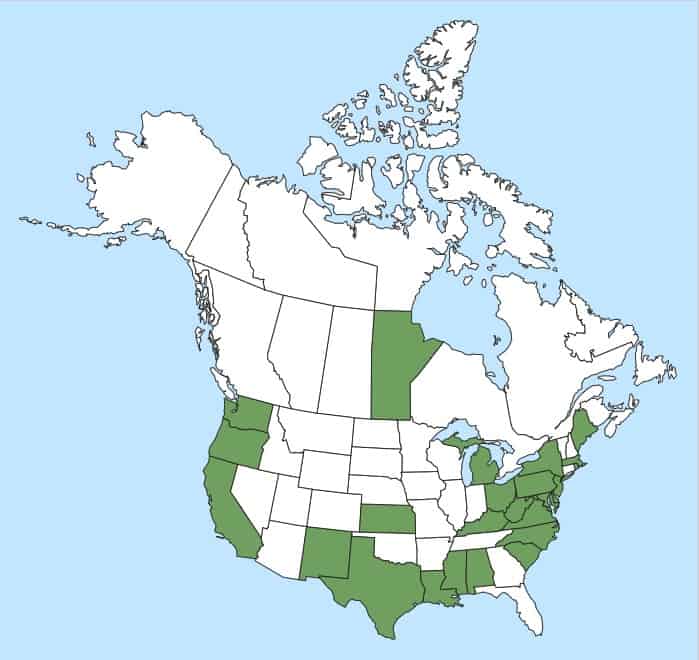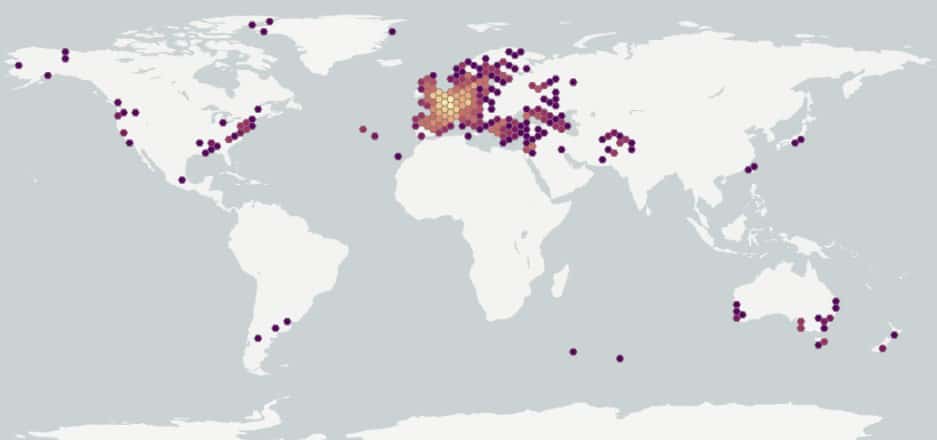Alopecurus myosuroides
Overview
Aperçu
Regulation :
Remarques Réglementation:
- CFIA Weed Seeds Order - Class 1: Prohibited Noxious Weed Seeds
- USA Federal Noxious Weed Seed List
Regulation Notes:
Prohibited Noxious, Class 1 in the Canadian Weed Seeds Order (2016) under the Seeds Act. All imported and domestic seed must be free of Prohibited Noxious weed seeds. Classified as a Restricted Noxious Weed Seed in the state of Washington (USDA-AMS 2021)
On Brazil, Colombia, Ecuador, New Zealand, Nicaragua, Peru, and Thailand lists of harmful organisms (USDA-PCIT-PExD 2021) (*may be updated without notice)
Distribution :
Répartition :
Native to northern Africa, Asia and Europe and introduced in Australia, New Zealand, China, North America (United States and, Mexico), and South America (Argentina and Chile) (Naylor 1972; CABI 2020; USDA-ARS 2021). In Canada, it was previously reported from British Columbia and Manitoba; populations did not persist (CFIA 2017).
Habitat and Crop Association :
Habitat et Cultures Associées :
Cultivated fields, moist meadows, forests, and disturbed ground. A significant weed of 23 crops in 37 countries, such as temperate cereal crops (United States Pacific Northwest and Western Europe) especially Triticum aestivum subsp. aestivum (winter wheat), Hordeum vulgare (barley), Avena sativa (oat), and Secale cereale (rye), and it also infests Brassica napus subsp. napus (canola, rapeseed), Phaseolus vulgaris (field beans), grass seed and forage legumes (Naylor 1972; Holm et al. 1997; Barkworth et al. 2007; CABI 2021).
Economic Use, cultivation area, and Weed Association :
Utilisation économique, zone de culture et association de mauvaises herbes :
Duration of Life Cycle :
Durée du cycle vital:
Annual
Dispersal Unit Type :
Type d’unité de dispersion :
Spikelet (containing a single floret)
General Information
RENSEIGNEMENTS GÉNÉRAUX
Primarily a weed of arable land, Alopecurus myosuroides is recognized as one of the most damaging weeds in winter cereals in western Europe (Naylor 1972). While the mechanism of introduction into the United States is not clear, specimens of A. myosuroides were collected in 1914 (CABI 2020). It is currently a problem in cereals in western Oregon and eastern Washington and has also spread into pastures (Lass and Prather 2007).
A. myosuroides appears to prefer poorly drained heavy clay and chalk soils but can tolerate sandy or gravelly soil (Naylor 1972). Each plant may produce 100-7600 seeds depending on the number of panicles per plant (autumn germinating plants produce greater numbers of dispersal units than spring germinating plants) that can be viable up to 4 years in soil; however, field studies indicate 60 – 70% of plants in an infestation are derived from seed that is less than one year old (Naylor 1972).
.Identification
Identification
-
Spikelet
Size
- Spikelet length: 4.7 – 6.5 mm, average 5.5 mm; width: 1.0 – 1.9 mm, average 1.5 mm (D. Meyer*).
- Spikelet length: 5.9 – 8.3 mm; width: 1.5 – 2.8 mm (CFIA **).
Additional size information from literature:
- Spikelet width 1.75 – 2.0 mm (Musil 1963).
- Spikelet length 4 – 7 mm (Naylor 1972).
- Spikelet length 4.5 – 7.5 mm (Tutin et al. 1980; Barkworth et al. 2007).
*Notes: minimum and maximum of 20 spikelets (CDA-S-21592) in a normal range of this species using image measurement protocol (ISMA 2020).
**Notes: minimum and maximum of 20 spikelets in a normal range of this species using image measurement protocol (ISMA 2020).
Shape
- Spikelet is narrowly oval to egg-shaped shaped, laterally compressed.
Surface Texture
- Glumes with leathery (coriaceous) structural thickness, surface granular and hairy.
Colour
- Spikelet is dull brownish-yellow coloured
Other Features
Glumes
- Glumes two, completely enclosing the single floret (excluding the awn), margins of the lower one-third to one-half of the glumes are fused together, tips of glumes are parallel or convergent, strongly keeled, and winged.
- Each glume has three longitudinal nerves, one central along the keel and two lateral (looking like raised longitudinal ridges).
- Glumes hairy on keels, lateral nerves, and above the spikelet callus (basal attachment scar).
- Hairs on lower half of glume keels are long and flexible (ciliate), hairs on upper half of the keels are short and stiff.
- The margins of the glumes have short stiff hairs
Spikelet Callus (spikelet attachment scar)
- The spikelet callus is ring-shaped and turned towards one side of the spikelet.
Other features
- Disarticulation of dispersal unit occurs below the glumes.
- Spikelets generally have one caryopsis, some have two (Naylor 1972).
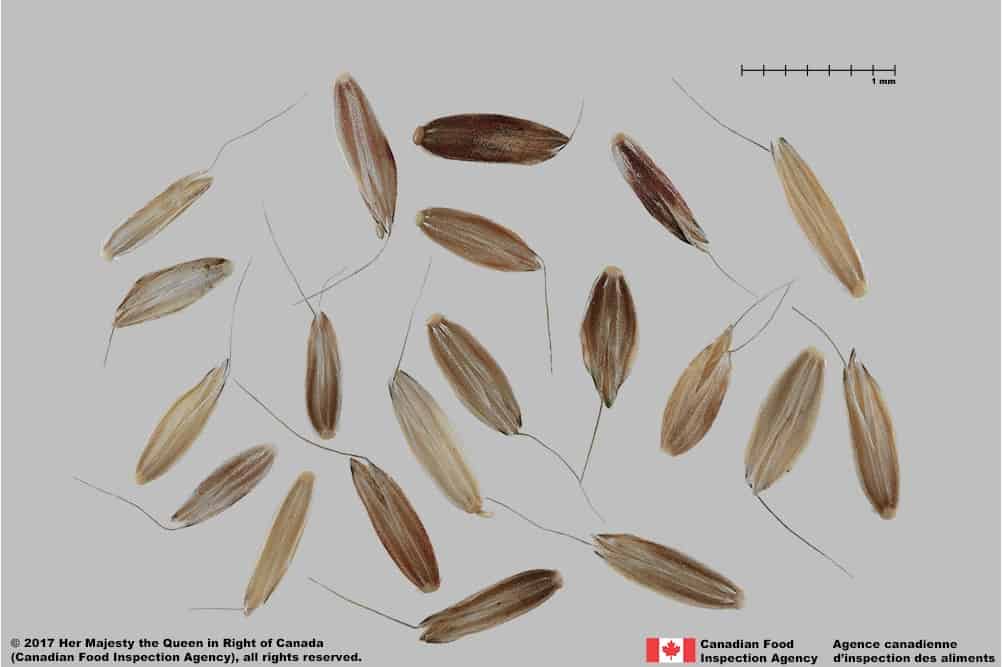
Slender foxtail (Alopecurus myosuroides); spikelets

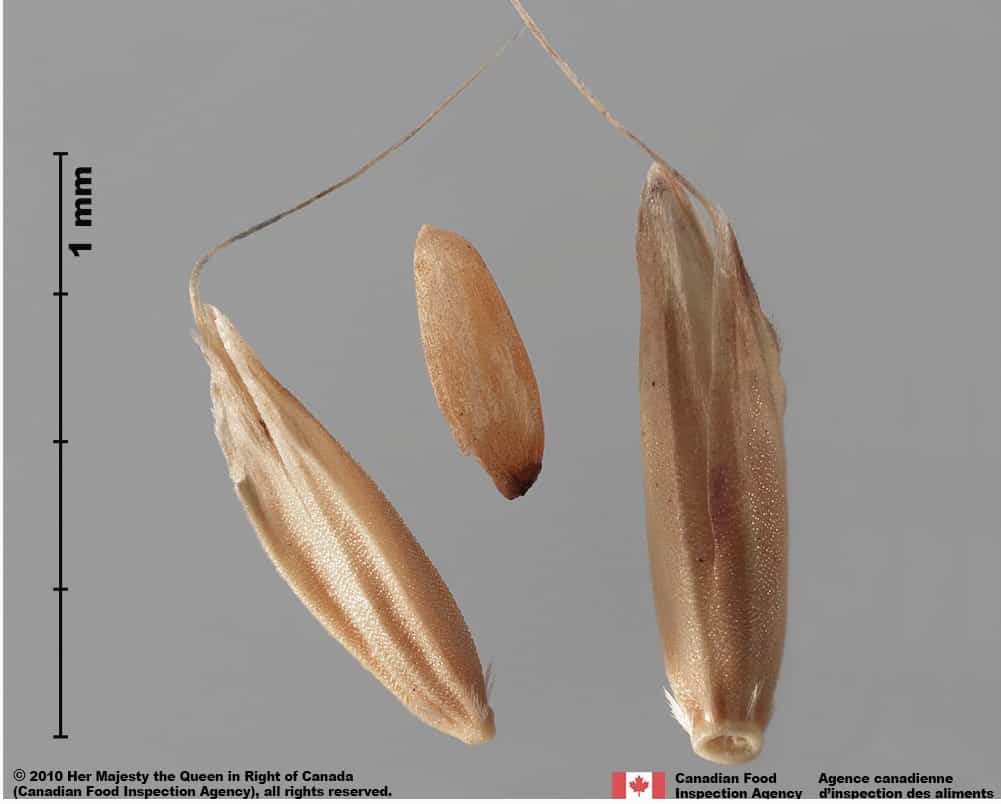
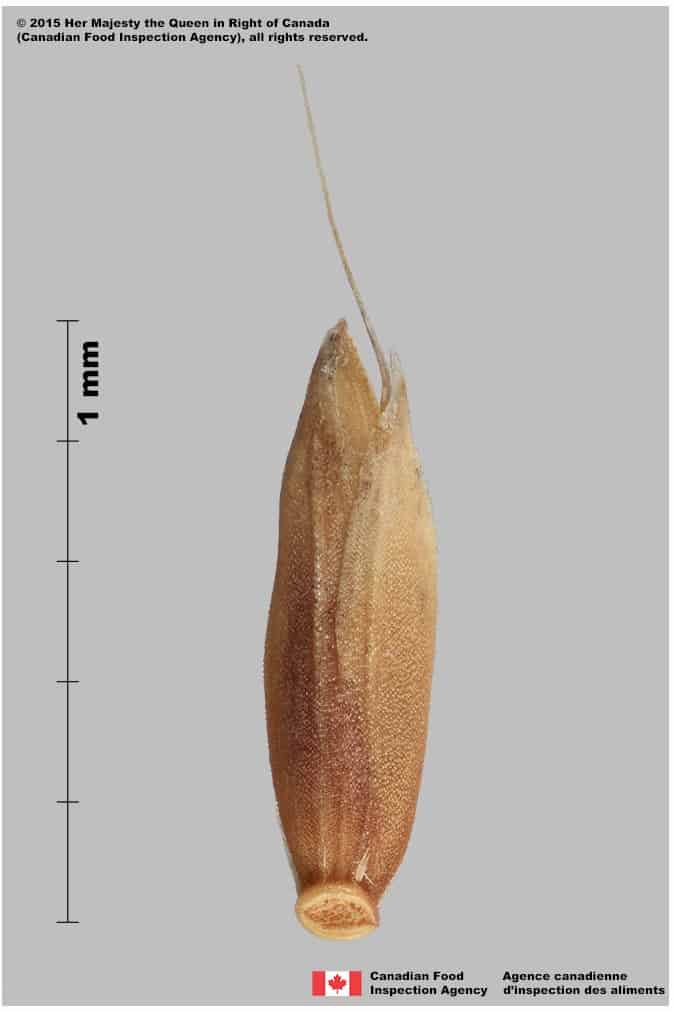
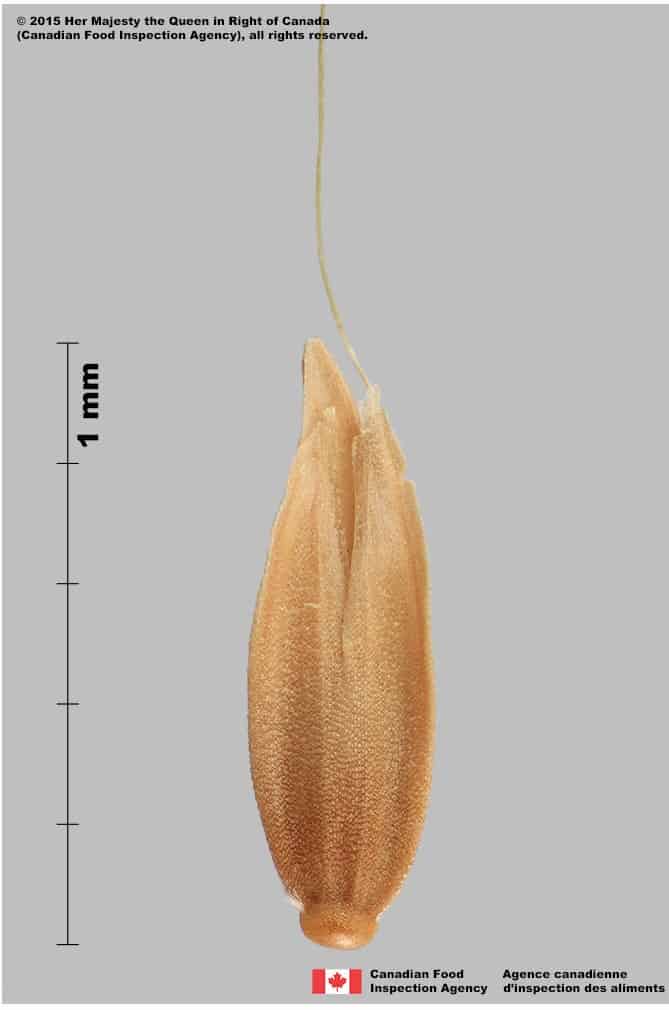
-
Floret
Size
- Floret length: 4.0 – 7.0 mm (Barkworth et al. 2007)
Shape
- The floret is narrow oval-shaped, laterally compressed
Surface Texture
- The lemma surface is smooth with 4-5 longitudinal nerves
Colour
- Floret is dull brownish-yellow
Other Features
Lemma
- The lemma is thin and papery (chartaceous), the margins are fused in lower one-third to one-half, completely enclosing the caryopsis
Lemma awns
- The awn is attached slightly above base of lemma and extends beyond the glumes, it is bent, and the bend is located near where the awn emerges from between the glumes
- Awn exceeding glumes by 3 – 4.7 mm (average 3.7 mm) (D. Meyer*)
- Awn exceeding glumes by 2.4 – 5.6 mm (CFIA**)
Additional size information from literature:
- Awn length from base of lemma: up to 12.0 mm; awn exceeding glumes by 3 – 6 mm (Barkworth et al. 2007)
*Notes: minimum and maximum of 20 awns (CDA-S-21592) in a normal range of this species using image measurement protocol (ISMA 2020).
**Notes: minimum and maximum of 20 awns in a normal range of this species using image measurement (ISMA 2020).Palea
- The palea usually absent or if present it is very short
Other features
- Lodicules absent (Naylor 1972; Barkworth et al. 2007)
- Anthers 2.4 – 4.1 mm long, yellow (Barkworth et al. 2007); 3 – 5 mm long (Naylor 1972)
-
Caryopsis
Size
- Caryopsis length: 2.25 – 3.2 mm, average 2.8 mm; width: 1.1 – 1.4 mm, average 1.2 mm (D. Meyer*)
Additional size information from literature:
- Caryopsis length: 2.0 – 3.0 mm (Naylor 1972); width: 1.0 – 2.0 mm (Holm et al. 1997).
*Notes: minimum and maximum of 5 caryopses (CDA-S-21592) in a normal range of this species using image measurement protocol (ISMA 2020).
Shape
- Caryopsis is oval shaped and laterally compressed
Surface Texture
- The surface of caryopsis is smooth
Colour
- The caryopsis colour is dull brownish-yellow
Other Features
Hilum
- The hilum is oval shaped and is located near base of caryopsis.
Style bases
- Style bases are fused together and sometimes visible on free caryopses as a pointed appendage on the tip of the caryopsis.
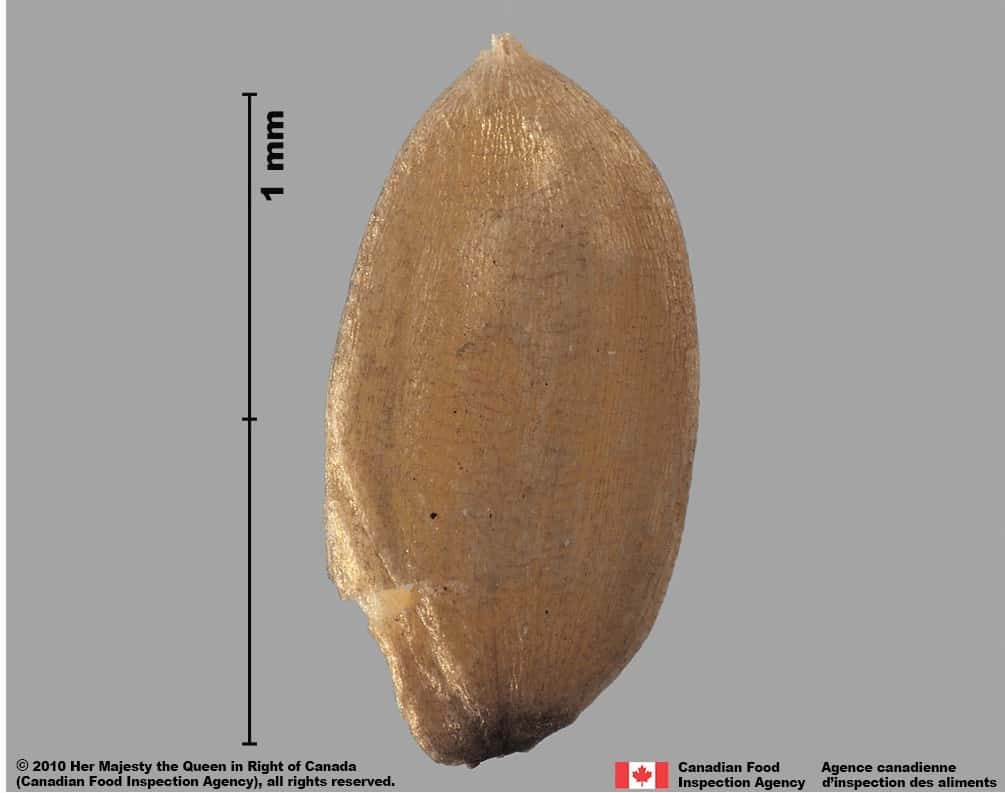
Slender foxtail (Alopecurus myosuroides); caryopsis

-
Embryo
Size
- The embryo one-fifth to one-third the length of the caryopsis
Shape
- The embryo is oval shaped
Endosperm
- The endosperm is semi-liquid and translucent yellowish coloured
Other Features
- Embryo is located along the (dorsal) edge of the caryopsis near the base.
Identification Tips
CONSEILS POUR L’IDENTIFICATION
Flattened spikelets with hairs along the edges and an awned lemma are general features of Alopecurus species. A. myosuroides spikelets are larger than many other species in the genus, brownish-yellow coloured and have ciliate hairs in lower one-half of glumes and around the spikelet callus.

Slender foxtail (Alopecurus myosuroides); spikelet





Additional Botany Information
AUTRES RENSEIGNEMENTS BOTANIQUES
Flowers/Inflorescence
- Lodicules absent (Naylor 1972; Barkworth et al. 2007)
- Anthers 2.4 – 4.1 mm long, yellow (Barkworth et al. 2007); 3 – 5 mm long (Naylor 1972)
- Each plant can produce one to several narrow, spike-like panicle inflorescences, ranging from 20-300 spikelets per plant (Naylor 1972)
- The inflorescence is 4 – 12 cm long and 3 – 7 mm wide (Barkworth et al. 2007)
Vegetative Features
- The plants form erect tufts, the stems up to 85 cm tall (Barkworth et al. 2007)
Similar Species
ESPÈCES SEMBLABLES
Similar species are based on a study of seed morphology of various species, and those with similar dispersal units are identified. The study is limited by physical specimen and literature availability at the time of examination, and possibly impacted by the subjectivity of the authors based on their knowledge and experience. Providing similar species information for seed identification is to make users aware of similarities that could possibly result in misidentification.
Alopecurus arundinaceus Poir.
Creeping foxtail (English) (Wiersema & León. 1999; AOSA 2021)
Creeping meadow foxtail (English) (Barkworth et al. 2007)
Vulpin roseau (French) (Barkworth et al. 2007)
Alopecurus arundinaceus is a short-lived perennial plant native to Eurasia and introduced in North America and used as a forage species (Barkworth et al. 2007). Compared to A. myosuroides, A. arundinaceus spikelets are generally smaller (spikelet length: 3.6 – 5.4 mm; width 1.2 – 1.8 mm; D. Meyer*) but there is some size overlap, the glumes are membranous and sparsely hairy, the keels are not winged and they have long ciliate hairs; the tips of the glumes are pointed and curve away from each other; the spikelet callus is less conspicuous; the lemma awn exceeding glumes by 0.5 – 4.7 mm (D. Meyer*).
*Notes: minimum and maximum of 10 spikelets (CDA-S-21576) in a normal range of this species using image measurement protocol (ISMA 2020).
Alopecurus geniculatus L.
Marsh foxtail (English) (Wiersema & León 1999)
Water foxtail (English) (Wiersema & León 1999; Barkworth et al. 2007)
Vulpin genouillé (French) (Wiersema & León 1999)
Vulpine géniculé (French) (Barkworth et al. 2007)
Alopecurus geniculatus is a perennial plant found in moist soils. The spikelets are smaller than those of A. myosuroides (length: 2.3 – 3.4 mm; width: 0.9 – 1.9 mm; D. Meyer**), oval or egg-shaped, the glumes membranous and covered with hairs, the keels are not winged, and they have long ciliate hairs; the spikelet callus is less conspicuous; the lemma awn exceed the glumes by 1.1 – 3.3 mm; the caryopsis is about one-half the size of those of A. myosuroides (1 – 1.5 mm long; Barkworth et al. 2007) (0.8 – 1 mm long; D. Meyer**).
**Notes: minimum and maximum of 64 spikelets in a normal range of this species using image measurement protocol (ISMA 2020) (CDA-S-21579, CDA-S-21580, CDA-S-21581, CDA-S-21583, CDA-S-21594).
Alopecurus pratensis L.
Golden foxtail grass (English) (Wiersema & León 1999)
Meadow foxtail (English) (Wiersema & León 1999; Barkworth et al. 2007; AOSA 2021)
Yellow foxtail grass (English) (Wiersema & León 1999)
Vulpin des prés (French)(Barkworth et al. 2007)
Vulpine de prés (French) (Wiersema & León 1999)
Wiesenfuchsschwanz (German) (Wiersema & León 1999)
Rabo-de-raposa (Portuguese) (Wiersema & León 1999)
Cola de zorra (Spanish) (Wiersema & León 1999)
Rabo de zorra (Spanish) (Wiersema & León 1999)
Alopecurus pratensis is a perennial plant found mostly in pastures, meadows, near bodies of water, and along roadsides (Barkworth et al. 2007). Compared to A. myosuroides, A. pratensis spikelets are generally smaller (length: 3.4 – 6.6 mm, width: 1.2 – 2.0 mm, D. Meyer***; length: 3.8 – 6.1 mm, width 1.2 – 1.9 mm, CFIA****) but there is some size overlap, the glumes are membranous, the keels are not winged, and they have long hairs; the spikelet callus is less conspicuous; the lemma awn exceeding glumes by 1.0 – 3.5 mm (D. Meyer***); the caryopsis is about one-half as long (1 – 1.2 mm; Barkworth et al. 2007).
***Notes: minimum and maximum of 10 spikelets (CDA-S-54836) in a normal range of this species using image measurement protocol (ISMA 2020).
****Notes: minimum and maximum of 10 spikelets in a normal range of this species using image measurement protocol (ISMA 2020).
Click to select species
Cliquez pour sélectionner les espèces
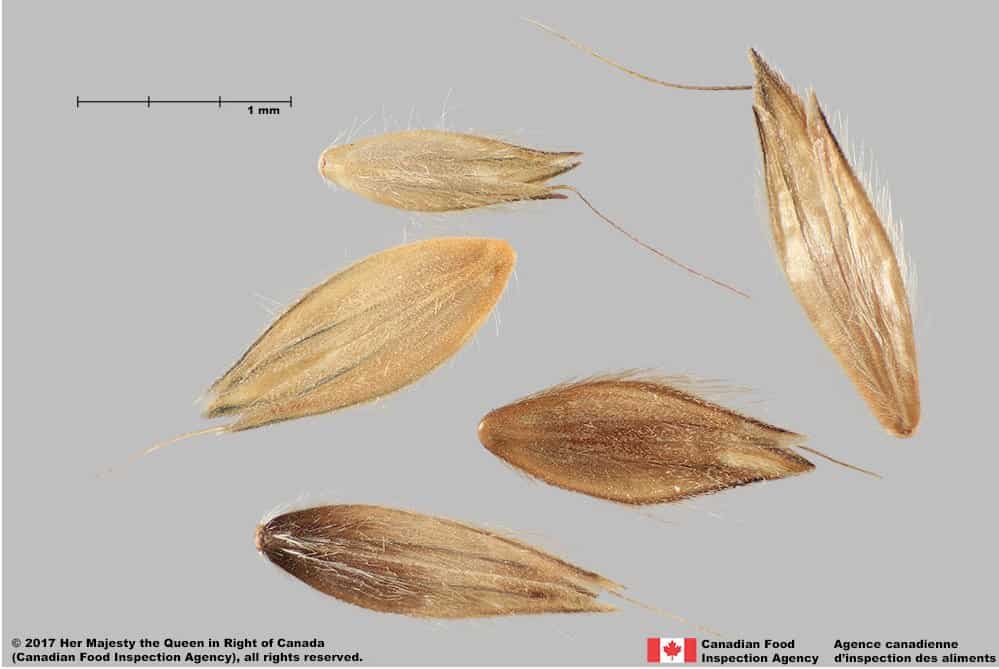
Alopecurus pratensis
Comparison Window
Fenêtre de comparaison
MAIN SPECIES
ESPÈCES PRINCIPALES
Alopecurus myosuroides

Alopecurus myosuroides
Poaceae
Slender foxtail (Alopecurus myosuroides); spikelets
MAIN SPECIES
ESPÈCES PRINCIPALES
Alopecurus myosuroides

Alopecurus myosuroides
Poaceae
Slender foxtail (Alopecurus myosuroides); spikelets and caryopsis
MAIN SPECIES
ESPÈCES PRINCIPALES
Alopecurus myosuroides

Alopecurus myosuroides
Poaceae
Slender foxtail (Alopecurus myosuroides); spikelet
MAIN SPECIES
ESPÈCES PRINCIPALES
Alopecurus myosuroides

Alopecurus myosuroides
Poaceae
Slender foxtail (Alopecurus myosuroides); spikelet
MAIN SPECIES
ESPÈCES PRINCIPALES
Alopecurus myosuroides

Alopecurus myosuroides
Poaceae
Slender foxtail (Alopecurus myosuroides); caryopsis
SIMILAR SPECIES
ESPÈCES SEMBLABLES
Alopecurus pratensis

Alopecurus pratensis
Poaceae
Meadow foxtail (Alopecurus pratensis); spikelets
SIMILAR SPECIES
ESPÈCES SEMBLABLES
Alopecurus pratensis
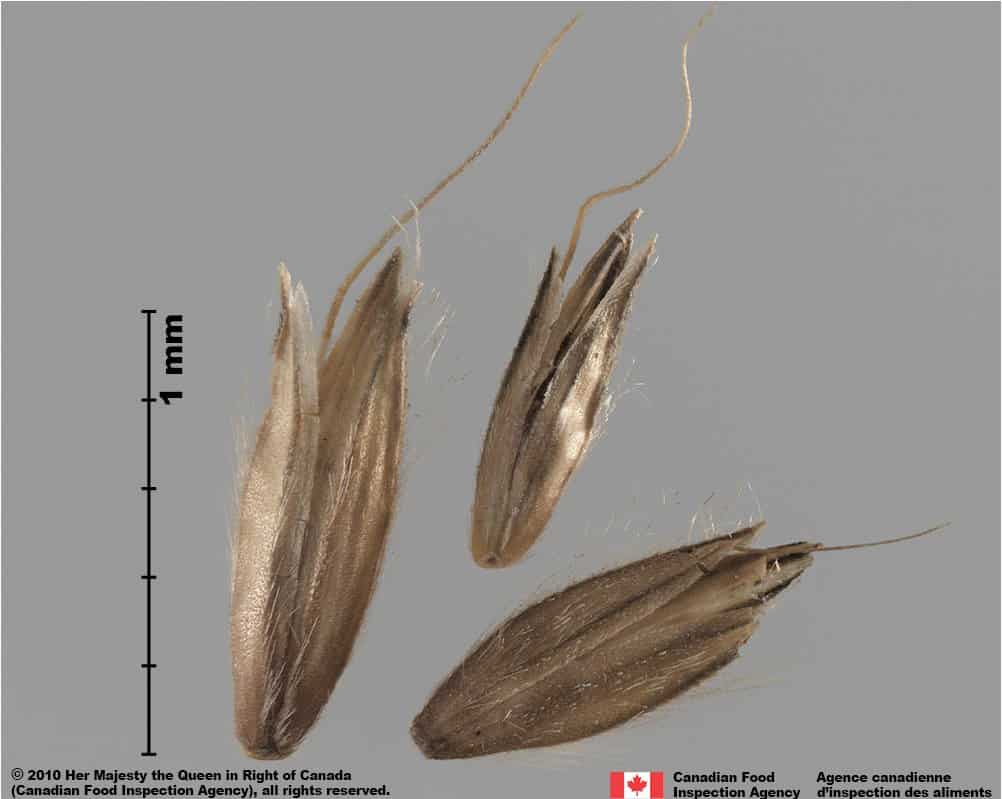
Alopecurus pratensis
Poaceae
Meadow foxtail (Alopecurus pratensis); spikelets
SIMILAR SPECIES
ESPÈCES SEMBLABLES
Alopecurus pratensis
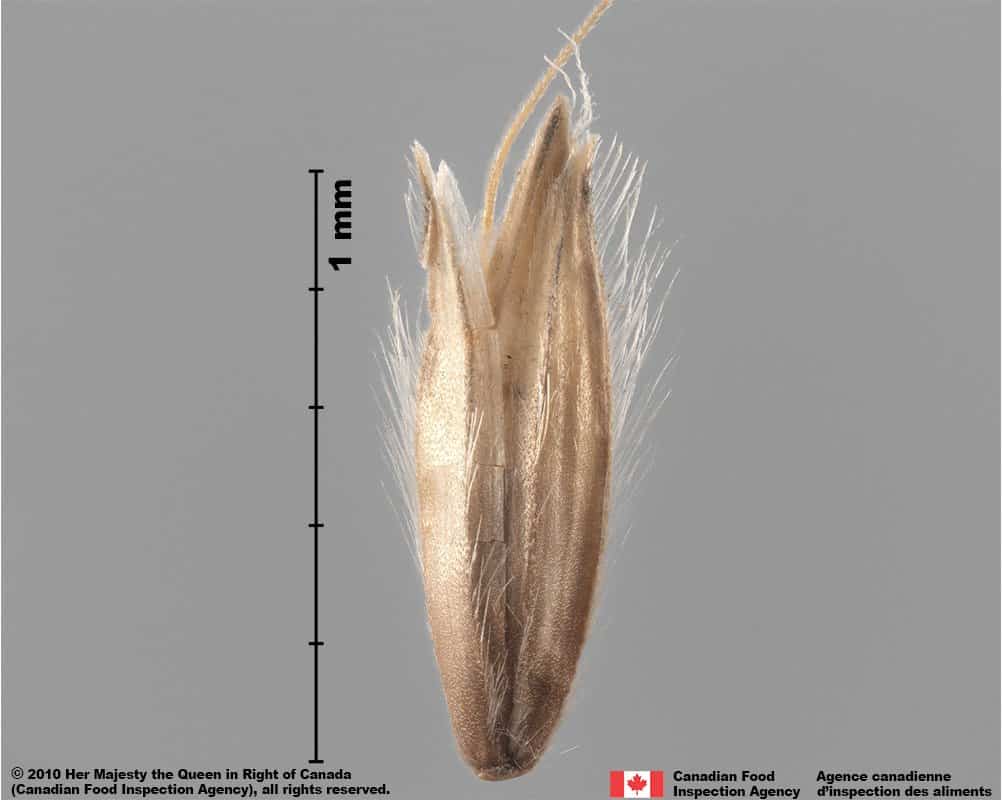
Alopecurus pratensis
Poaceae
Meadow foxtail (Alopecurus pratensis); spikelet
Need ID Help?
Besoin d’aide pour l’identification?
Reference(s)
Référence(s)
Association of Official Seed Analysts (AOSA). 2021. AOSA Rules For Testing Seeds. Volume 3: Uniform Classification of Weed and Crop Seeds. AOSA, Washington, DC.
Barkworth, M. E., Capels, K. M., Long, S. and Piep, M. B. (eds.). 2007. Flora of North America Volume 24. Magnoliophyta: Commelinidae (in part): Poaceae, part 1. Oxford University Press, New York, New York.
Centre for Agriculture and Bioscience International (CABI). 2022. Invasive Species Compendium, CAB International, Wallingford, UK. https://www.cabidigitallibrary.org/journal/cabicompendium Accessed December 29, 2020.
Canadian Food Inspection Agency (CFIA). 2017. Invasive Plants Field Guide. Canadian Food Inspection Agency, Ottawa, ON.
Darbyshire, S. J. 2003. Inventory of Canadian Agricultural Weeds Agriculture and Agri-Food Canada. 37.
Flora of North America (FNA) Editorial Committee, eds. 1993+. Flora of North America North of Mexico [Online]. 22+ vols. New York and Oxford. http://floranorthamerica.org/Alopecurus_myosuroides Accessed December 29, 2022.
Global Biodiversity Information Facility (GBIF) Secretariat. 2022. https://doi.org/10.15468/39omei Accessed via https://www.gbif.org/species/5290097 Accessed December 29, 2022.
Government of Canada (GC). 2016. Canadian Weed Seeds Order. https://laws-lois.justice.gc.ca/eng/regulations/SOR-2016-93/page-2.html (English) https://laws-lois.justice.gc.ca/fra/reglements/DORS-2016-93/page-2.html (French)
Holm, L., Doll, J., Holm, E., Pancho, J., and Herberger, J. 1997. World Weeds: Natural Histories and Distribution. John Wiley and Sons, Inc., New York 1129 pp.
International Seed Morphology Association (ISMA) 2020. Method for Seed Size Measurement. Version 1.0. ISMA Publication Guide. https://www.idseed.org/authors/details/method_for_seed_size_measurement.html
Lass, L. and Prather, T. 2007. A Scientific Evaluation for Noxious and Invasive Weeds of the Highway 95 Construction Project between the Uniontown Cutoff and Moscow. AquilaVision Inc., Missoula, MT.
Musil, A. F. 1963. Identification of Crop and Weed Seeds. Agriculture Handbook No. 219. U. S. Department of Agriculture. Washington, D.C.
Naylor, R.E.L. 1972. Biological flora of the British Isles: Alopecurus myosuroides Huds. (A. agrestis L.). Journal of Ecology 60: 611-622. https://doi.org/10.2307/2258364.
Tutin, T. G., Heywood, V. H., Burges, N. A., Moore, D. M., Valentine, D. H., Walters, S. M., Webb, D. A. (Eds.). 1980. Flora Europaea. Volume 5 Alismataceae to Orchidaceae (Monocotyledones). Cambridge University Press.
U.S. Department of Agriculture-Agricultural Marketing Service (USDA-AMS). 2021. State Noxious-Weed Seed Requirements Recognized in the Administration of the Federal Seed Act (Revised July 2021). https://www.ams.usda.gov/sites/default/files/media/StateNoxiousWeedsSeedList.pdf
U.S. Department of Agriculture-Agricultural Research Services (USDA-ARS). 2021. Germplasm Resources Information Network (GRIN), https://npgsweb.ars-grin.gov/gringlobal/taxon/taxonomydetail?id=2650. Accessed November 15, 2021.
U.S. Department of Agriculture-Natural Resources Conservation Service (USDA-NRCS). 2022. The PLANTS Database. National Plant Data Team, Greensboro, NC USA. https://plants.usda.gov/home Accessed November15, 2021.
U.S. Department of Agriculture- Phytosanitary Certificate Issuance and Tracking System- Phytosanitary Export Database (USDA-PCIT-PExD). 2021. Phytosanitary Export Database (PExD) System. PExD contains phytosanitary import requirements of U.S.-origin commodities to foreign countries. https://pcit.aphis.usda.gov/PExD/faces/ViewPExD.jsp. Accessed November 11, 2021.
Wiersema, J. H. and León, B. 1999. World Economic Plants: A Standard Reference. CRC Press, Boca Raton, FL.



